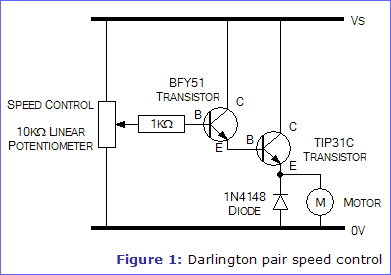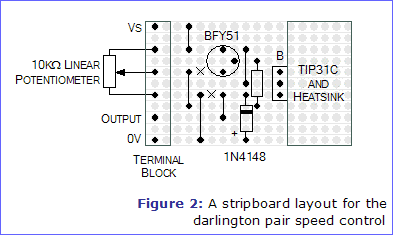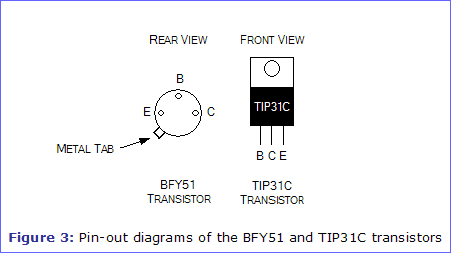Darlington Pair Speed Control
By John Hewes
A normal potentiometer (variable resistor) cannot directly control the speed of a motor since motors draw large amounts of current which would burn out the potentiometer. Instead, the small amount of current that the potentiometer can pass can be amplified into order to run the motor. This amplification can be achieved using transistors.
The job of a transistor is to allow the small amount of current that enters its 'base' terminal to control the amount of current flowing from its 'collector' terminal to its 'emitter' terminal. This allows a low power circuit to control a higher power circuit, either in an on/off fashion or linearly.
| Further Information | Transistors - This article is not yet available |
The circuit in figure 1 shows a linear potentiometer connected between Vs and 0V such that the voltage at its wiper terminal will always be somewhere at or between these two voltages.
The small amount of current flowing out of the potentiometer's wiper is amplified by two transistors, connected together in a configuration known as a 'Darlington pair'. The current from the potentiometer is amplified by the first transistor, and then again by the second transistor, greatly increasing the amount of current that can be controlled by the potentiometer.
There are, however, a couple of disadvantages of this simple circuit. Firstly, about 0.7V is lost in each transistor, so the maximum voltage that can ever be applied to the motor is Vs - 1.4V. Secondly, the transistors are not absolutely linear so the change in motor speed for a given rotation of the potentiometer will be more subtle in the middle of its range.
Because a motor is an inductive load, it will produce a 'back-emf' which could damage the second transistor. The 1N4148 signal diode prevents this damage by shorting out the back-emf.
This circuit can also be used to control other devices - it could be used as a lamp dimmer for example.

A stripboard layout for this circuit is given in figure 2. The layout includes space for an optional 6-way screw terminal block to make connecting up the circuit easier.

The power supply for this circuit should preferably be un-smoothed (i.e. directly from the power supply rectifier). This helps prevent the motor 'sticking' at low speeds. With the TIP31C transistor given, the maximum power supply voltage may be 60V and the maximum motor current consumption may be 3A.
Pin-out diagrams of the two transistors used in this circuit are given in figure 3. The TIP31C transistor will get hot in use because the high current supplying the motor flows through it. You should therefore fit a heat sink to it to dissipate the heat - a suggested heat sink is given in the Shopping List, or you could make one out of Meccano! Space is provided in the stripboard layout for a heat sink, but the positions and sizes of the holes are not shown for they will depend on the nature of the heat sink you choose.

The article below describes another version of the Darlington pair circuit which reduces the voltage loss to 0.7V.
| Related Articles | Another Darlington Pair Speed Control |
Article Information
Source: Electronics in Meccano - www.eleinmec.com
| First published in EiM: Issue 8 (July 2000)
Topic: Controlling Motors |
Created: 26/03/2002 |
Last modified: 02/08/2007
Top of Page | Homepage | About | Search | Topics | Features | Circuits Shop | yourEiM |
© 1998 - 2025 Tim Surtell |